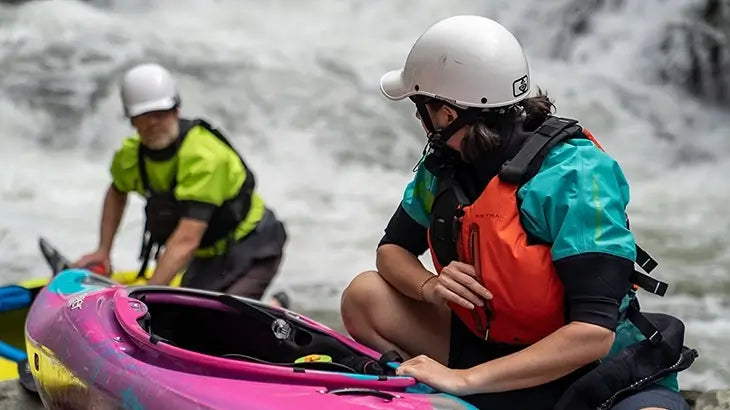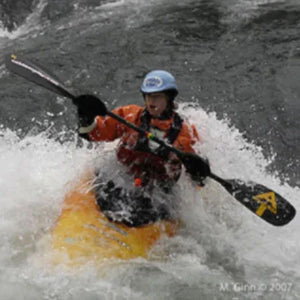What to Wear Kayaking
December 08, 2022

Kayaking should be about having fun on the water. You should be comfortable and safe in your kayak to maximize your smiles per stroke. The first step is to dress in the appropriate kayak outerwear.
If you’re just out for a lazy paddle on the lake in your inflatable kayak, you’re unlikely to take a swim, but it can happen. On the other end of the spectrum is playboating in a whitewater kayak, where you are sure to be splashed, knocked around, and more likely to be tossed out of your kayak.
Be sure to factor in the type of kayaking, activity level, air temperature, and water temperature when determining your apparel choices for a day on the water. With those factors in mind, let’s look at the kayak clothing that will keep you comfortable on the water.
Life Jackets
Life jackets are the most essential safety accessory for kayakers of all levels, whether leisurely paddling on a calm lake or navigating the challenging waters of whitewater kayaking. A properly fitted life jacket, also known as a personal flotation device (PFD), keeps you afloat in case of an unexpected capsize. And using a life jacket isn’t just a smart move. It’s the law.
To choose the proper kayaking and canoeing life jacket, you must consider factors like body size, the boating environment, and paddling behavior. For example, a life vest with high mobility and a snug fit is ideal for whitewater or playboating, where frequent movement and potential water immersion are expected. Conversely, a life jacket with ample storage and comfort for prolonged wear might be more appropriate for calm water kayaking or fishing.
Regardless of your choice, ensure your life jacket is certified, fits well, and does not impede your paddling motion. Remember, a life jacket can only save your life if you're wearing it. Make it a habit to wear your PFD every time you hit the water, ensuring your kayaking adventure is enjoyable and safe.
Paddling Tops & Bottoms
Layers are your friend during outdoor adventures, and paddling is no different. You’ll first want to consider an outer layer, which blocks the wind, water splash, and sun. And then you’ll want a next-to-skin insulating/wicking layer to keep you warm and comfortable as you paddle.
A kayak dry top has latex gaskets at the wrists and neck to keep you dry. This outerwear style is more popular with whitewater and sea kayakers who might roll their kayaks regularly. A semi-dry top has latex wrist gaskets, but the neck gasket is neoprene, making it more popular for kayak anglers, rafters, or folks who prefer a bit more comfort than latex.
Outer Layers
You can wear various paddling-specific outer layers to protect yourself from the elements or splash. Paddling style, environment, and budget will all affect your outerwear choices.
The most basic and least expensive options include a paddling jacket, splash pant combo, and a paddling-specific rain suit. Splash gear usually offers velcro wrist and ankle closures to keep water from running down your sleeves and up your pant legs while paddling, but it provides little protection if you take a swim.
A kayak dry top and dry pants combo offers latex gaskets at the wrist and neck and a double-tunnel system at the waist, a significant step up in protection and cost. Keeping your skin and underlayers dry allows this system to be used in a wide range of weather. Combined with a quality spray skirt, this system keeps most of the water from splashes, rain, and/or rolling out of your kayak.
The ultimate in kayaking outwear is a kayak drysuit, similar to the dry top and pants combo but integrated into one unit, allowing it to be 100% dry even when fully submerged. Drysuits are an investment and are your safest option when kayaking in rough weather and during cold water kayaking trips, though wetsuits also have their benefits.
Insulating & Wicking Layers
A key to comfort while kayaking is choosing the fitting next-to-skin shirt and pants. Again, activity level, water temperature, and style of kayaking will help direct these choices.
Union Suits
Wearing insulating layers next to the skin helps with heat retention. Many times, it’s okay just to wear a next-to-skin layer and skip the outer layers. If it’s a hot day, you might just wear a thin NRS hydroskin shirt and paddling shorts, which protect you from the sun and help keep you cool through evaporative cooling. On a colder day, you might wear a thicker neoprene top and pants, which offer excellent warmth retention but can restrict freedom of movement. You may also consider a kayaking wetsuit.
In nasty weather or cold-water environments, you will want to wear an appropriate outer layer to protect you from the elements. However, kayaking outerwear offers little to no insulation and can feel clammy against the skin. It is usually best to wear an insulating layer next to the skin that helps with heat retention, insulates from cold water, wicks moisture away, and is a barrier between your skin and the clammy outerwear. Synthetic and wool are good material options here; the air and water temp determines thickness. Add more insulating layers with layering tops and pants when it gets icy.
Kayak Footwear
Neoprene booties provide traction on slippery surfaces. Not all kayaking shoes are made of neoprene. Another option would be kayak shoes. No matter which style you choose, proper kayaking footwear is vital to safety and comfort. You’ll surely encounter slick, wet surfaces while getting in and out of your boat or portaging around a hazard on the river. The key to a good day on the water is getting to, from, and around the edges of the water safely and without slipping.
It is also essential to select kayak shoes that will stay on your feet if you take a swim, as your shoes are no good to you if they float away. All-day comfort is also crucial, so choose footwear that fits inside your kayak and doesn’t have lousy pressure points when seated. Most water shoes are designed to be worn barefoot and should fit snugly to your foot. If you are wearing a dry suit with attached socks, be sure to go up a size for room for your fleece or wool socks and the attached so that you don’t pinch your toes.
Neoprene booties can offer good warmth, comfort in the kayak, and grip on wet rocks, but they often don’t provide a perfect sole for walking any distance over rough terrain.
River shoes offer great comfort when walking around and protection for your feet from sharp rocks but offer little warmth and can be bulky to fit inside some kayaks. River sandals are great on sunny, warm days, offering excellent traction on wet rocks and impact protection. Still, they can be uncomfortable to wear while seated in your kayak and provide no additional warmth.
There are kayaking shoes, neoprene booties, river sandals, and even tall boots designed for specific kayaking applications and weather conditions. Choosing the right one for your style of kayaking will depend on your foot size, kayaking environment, and weather conditions.
Hand Wear
Gloves and pogies will keep your hands warm in cold waters. Extremities are the first body parts to get cold, and your hands are also more exposed to the water during all types of kayaking than any other body part. Bare hands give you great control and feel of your paddle but can also cause blisters and expose your hands to wind and water. There are three types of handwear that most kayakers consider.
The most minimal is an essential paddling glove. Only ½ a finger is often exposed, which gives you a little padding on the palm. Sun protection helps prevent blisters and provides a sure grip on the paddle. These gloves offer little to no warmth, however.
The next step up is a full neoprene glove. These come in a wide variety of thicknesses and styles. The thinner the gloves are, the easier it will be to feel the paddle shaft, but thin gloves can be chilly on those colder days. Thicker gloves are warmer but can make it harder to keep a solid grip on your paddle and require a tighter hand, which can add to paddler fatigue in the wrists, forearms, and shoulders.
The third handwear option is pogies. Pogies are pockets of material that Velcros onto your paddle shaft. The idea is that they protect your hands from splashes and wind while retaining heat inside the pocket. The HUGE benefit of pogies is that you have direct contact with the paddle shaft, which provides the best feel and control of the paddle. Some paddlers will combine thin neoprene gloves with pogies on colder, icy days on the water for the best grip and warmth.
Headwear
Your head is a significant temperature regulator for the body. If you’re unlikely to end up in the water, a simple wool or synthetic beanie cap will keep the wind and water off your head and make a remarkable difference in your heat retention.
Broader-brim hats like this Kokatat Seawester do a great job keeping the sun off your neck and face. If you are going to be upside down in icy water or likely to take a swim, a neoprene kayak hat or helmet liner is more appropriate.
You can enjoy paddling year-round with the proper kayak gear and the best kayak accessories. Life is better from the seat of a kayak. Get out and paddle!

